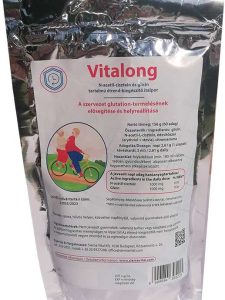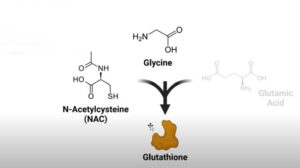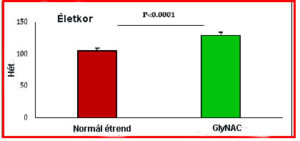Vitalong
Powder for Drinks with N-Acetyl-L-Cysteine and Glycine
Healthy Mitochondria for Longevity and Health
Summary
- Until recently there were no solutions to improve age-related disorders/declines.
According to the classical theory of aging, the main triggering factors of aging are oxidative stress (OxS) and mitochondrial dysfunction, which stimulate each other in the aging process.
A critical regulator OxS, mitochondrial function and the immune system, is glutathione, which consists of three amino acids (glycine, cysteine, glutamic acid).
Instead of direct glutathione supplementation, it is beneficial to support the cells’ own glutathione production capacity by supplementing glutathione precursors (glycine and cysteine, the latter in the form of N-acetylcysteine (NAC).
Glycine+NAC (GlyNAC) supplementation achieved outstanding results in clinical trials:
- in animal trials: improved/corrected glutathione deficiency, increased the lifespan of old mice by 24%.
- in a pilot trial in elderly people: corrected glutathione deficiency, OxS and mitochondrial dysfunction, improved signs of aging.
- in a randomized, placebo-controlled clinical trial in elderly people: confirmed the results of the pilot trtial and previous studies (improved glutathione deficiency, OxS, mitochondrial dysfunction, insulin resistance, impaired physical functions and aging characteristics, inflammation, endothelial dysfunction, increased waist circumferenceand gait speed).
- Conclusions of the studies: by combining the benefits of glycine, NAC and glutathione, GlyNAC is an effective option for solving many age-related disorders.
- Vitalong is the first Hungarian glycine+NAC food supplement.
Aging, redox balance, mitochondria and glutathione
According to the oxidative stress (OxS) theory of aging, the process of aging is triggered by accumulation of oxidative damage generated by free radicals.¹ According to the classic form of the theory, all free radicals (oxidants) are bad. Mitochondria (the mini power plants of our cells) release more and more oxidants (free radicals) over time, damaging all parts of the cells, which also leads to aging. Therefore, oxidants must be reduced/neutralized. The research results, however, did not confirm this (e.g., in one study, genetically modified mice produced more free radicals, but this did not accelerate aging 2).
Instead of reducing free radicals, we now try to find the optimal redox (reductive-oxidative, meaning between antioxidants and oxidants) balance. Too many oxidants can lead to oxidative, and too many antioxidants can lead to reductive stress. At the heart of the redox balance is glutathione, which is a critical regulator of oxidative stress and immunity. 4
According to the new approach, oxidants are stress-induced survival signs that signal to cells that they must work more efficiently to protect the mitochondria. As we age, the levels of oxidants increase in order to survive, until they betray their original purpose and end up exacerbating age-related damage instead. 3
Mitochondria produce the energy needed to support cell functions. Therefore, normal mitochondrial function is critical for a healthy life. The head of GlyNAC research, dr. Rajagopal Sekhar, professor at Baylor College of Medicine believes that improving the functions of mitochondria during aging is the key to healthy aging. “Energy supports life, and mitochondria provide energy. I believe that mitochondrial health is vital to our well-being, and as we age, maintaining mitochondrial health should have high priority in our efforts to improve overall health,” said Sekhar.
Recently, research has focused on how new nutritional interventions can help correct glutathione deficiency in order to achieve redox balance. Research on the supplementation of glutathione precursors has produced outstanding results in supporting glutathione synthesis and combating the accumulation of damage.
Glutathione: Functions and Composition
The main functions of glutathione, known as the “master antioxidant”: 4,5
- chemical neutralization of free radicals
- cofactor of many antioxidant enzymes
- regeneration of vitamins C and E
- binding of free radicals produced by the neutralization of chemical toxins in the liver
- rendres the by-products of detoxification in the liver water-soluble, so they can be excreted through the kidneys
- removal of mercury (also from the brain)
- regulation of cell proliferation and apoptosis (programmed cell death)
- maintenance of mitochondrial DNA
Glutathione levels in cells decrease with age.⁶⁻⁷ This decrease can cause an imbalance between free radicals and glutathione, which contributes to oxidative damage within cells.³
All of our cells produce glutathione, as they generally need it, but glutathione deficiency is very common (prediabetes, diabetes, heart disease, neurodegenerative diseases, e.g. dementia, and certain tumor diseases).
This unique molecule is produced by three amino acid precursors (cysteine, glycine, and glutamic acid). Of these, glycine and cysteine are critical (rate-limiting meaning if they are not available in sufficient quantities, the biochemical process (glutathione synthesis) slows down, almost stops). ⁴ Glutamine is abundantly available, and we consume N-acetyl-cysteine instead of the rarely found cysteine.
Glutathione Supplementation vs. Taking the Building Blocks for Our Own Glutathione Synthesis?
Taking glutathione supplements is not optimal for two reasons.
1. Glutathione supplements are unstable (under normal atmospheric conditions or at room temperature) and are not absorbed. 5
2. Even if a certain glutathione preparation is well absorbed (e.g. liposomal glutathione), the problem is to find the optimal balance between oxidants and antioxidants. If cells receive glutathione directly, they cannot regulate the amount of antioxidants they need. Each tissue requires different amounts of glutathione based on its metabolic needs. This need is dynamic and changing. Therefore, the cells themselves regulate the synthesis of glutathione. Adequate glutathione levels within the cell are ensured by cell synthesis, not glutathione supplementation or administration.
An excessive reduction in the amount of oxidants leads to cell damage called “reductive stress”. Cells must maintain a delicate balance between reducing oxidative stress and avoiding reductive stress. For example, the excessive dosage of NAC or glutathione resulted in accelerated aging in earthworms. In contrast, glycine + NAC supplementation increased lifespan in mice. 6
Breakthrough Clinical Results with NAC + glycine
In aged mice: increased lifespan by 24%
GlyNAC (1.6 mg/g) vs. placebo
Endpoints:
- lifespan
- glutathione deficiency, oxidative stress, mitochondrial dysfunction,
abnormal mitophagy and nutrient sensing, genomic damage in the heart, liver and kidney (all related to aging) 6

Pilot Trial in Elderly People: GlyNAC Improved Parameters of Aging, Discontinuation Resulted in Loss of Benefits
A 36-week open-label clinical trial was conducted in eight elderly (IE) and eight young adults (FF). After all participants underwent an initial (pre-supplementation) examination, FFs were excluded from the study. IEs were re-examined 24 weeks after GlyNAC supplementation and 12 weeks after GlyNAC withdrawal.
Capsule (100 mg/kg GlyNAC): glycine (1.33 mmol/kg/day), cysteine (0.81 mmol/kg/day, (as NAC)
The tested parameters:
- glutathione level (in red blood cells);oxidative stress
- inflammation,
- endothelial function
- glucose and insulin levels
- walking speed
- grip strength
- six minute walking test
- cognitive tests
- genome damage
- body composition 7
Conclusions of the Clinical Trial
Compared to healthy young adults, older people have high levels of oxidative stress and glutathione deficiency, impaired mitochondrial function, increased inflammation, insulin resistance and endothelial dysfunction, and lower muscle strength and mental abilities.
GlyNAC improved the above parameters, discontinuing it resulted in loss of benefits. 7
Placebo-controlled Study in Elderly People: GlyNAC improved and reversed several age-related abnormalities (glutathione deficiency, mitochondrial function, physical function, waist circumference, endothelial function, systolic blood pressure, and signs of aging).
Placebo-controlled study in humans
12 young people (21-40 years): GlyNAC (glycine and NAC each 100 mg/kg/day) for 2 months
24 elderly (61-80 years) (BMI˃27): GlyNAC (N = 12) (100mg/kg) or placebo (alanine)
Tests at 0, 2, 16 weeks
Parameters:
glutathione level,
oxidative stress,
energy metabolism,
inflammation,
endothelial function,
symptoms of aging (mitochondrial dysfunction, abnormal nutrient sensing, altered intercellular communication, loss of proteostasis, genomic instability, stem cell decline, cell aging, telomere changes);
walking speed,
muscle,
six minute brisk walk,
body composition,
blood pressure 8

mean value ± standard deviation, FIA = young adults, PLA = placebo group, GLY = GlyNAC group
Conclusions of the Clinical Trial
Compared to healthy young adults, older people have glutathione deficiency, oxidative stress, mitochondrial dysfunction (with faulty molecular regulation), inflammation, endothelial dysfunction, insulin resistance, impaired physical functions, increased waist circumference, and systolic blood pressure.
GlyNAC (and not placebo) improved the above parameters in elderly people.
GlyNAC did not reduce oxidative stress in young adults.
GlyNAC Supplementation for 16 Weeks in Seniors is a safe, effective supplement that improves and reverses many age-related disorders to promote health in aging individuals. 8
When should you think about glutathione deficiency? What should be measured?
Conditions associated with glutathione deficiency:
- mitochondrial dysfunction,
- accelerated aging,
- increased oxidative stress
- prediabetes, diabetes,
- heart diseases,
- degenerative nerve diseases (e.g. dementia),
- certain cancers
Glutathione-related biomarkers, lab values
- Gamma-glutamyl transpeptidase (gamma-GT) (liver enzyme): helps transport glutamine into cells; shows a high value in prediabetes, diabetes, heart disease, hypertension, alcoholism. Correlation between organic environmental toxins and gamma-GT, especially recommended when doctors suspect alcoholism
- ALT (liver enzyme): : shows a high level in hepatitis, cirrhosis, liver cancer, other liver diseases, certain drugs or toxins
Who/When Do We Recomment Taking Vitalong?
- Toxins, detoxification
- Liver disease
- Heart disease, hypertension
- Alcohol consumption: its breakdown products are toxic to the liver
- Smoking: production of free radicals
- NAC: bronchitis, COPD, COVID (severe), withdrawal treatment (smoking, alcohol, addiction)
- Glycine: prediabetes, diabetes (improves insulin sensitivity)
Vitalong: Replenishing the Building Blocks of Glutathione
Net weight: 156 g (60 servings)
Ingredients: glycine, N-acetyl-L-cysteine, sweetener (erythriol + stevia), lemon flavor
Dosage: 2.61 g per day (one level coffee spoon, 2 ml)
Active ingredient content of the recommended daily dose
- N-acetyl cysteine 1000 mg
- Glycine 1000 mg
Use: mixed thoroughly in liquid (min. 180 ml water, tea, fruit juice) and consumed between meals.
Warnings: Not recommended for children and pregnant or lactating women
References
- Harman D. J Gerontol. 1956;11(3):298-300;
- Perez VI et al. Aging Cell. 2009; 8:73–75;
- Lopez-Otin. Cell 2013, Jun. 6.153 (6)) : 1194-1217
- Richie et al. Eur J Nurt 2015. március; 54 (2): 251-63
- Townsend et al. Biomed Pharmacother 2000 május-június; 57 (3-4): 145-155
- Kumar P, Sekhar R. Nutrients 2022, 14, 1114;
- Kumar P et al. Clin. Transl. Med. 2021;11:e372.
- Kumar P et al. J Gerontol A Biol Sci Med Sci, 2023, Vol. 78, No. 1, 75–89















